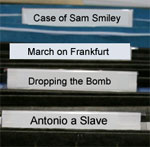BROWSE BY CATEGORY
- Archives and Libraries
- Blogs and Networking
- Bookmark This
- Digital Tools
- Examples of Teaching
- Exhibits
- Film Reviews
- History and Headlines
- Historic Sites and Museums
- Historical Thinking
- Holidays and Heritage
- Issues and Research
- Lesson Plans
- Material and Visual Culture
- Multimedia
- Organizations and Agencies
- Primary Sources
- Professional Development
- Publications
- Student Activities
- Teaching Materials
- Websites
Bringing Primary Sources into the Classroom

It's one thing to introduce primary sources in the K-12 history classroom; sometimes it's quite another to engage students in exploring them. H.S.I: Historical Scene Investigation, a joint project of the College of William and Mary School of Education, the University of Kentucky School of Education, and the Library of Congress Teaching with Primary Sources Program helps you involve your students as historical detectives.
H.S.I offers fourteen open cases (not all of which are complete), collections of primary sources organized around themes such as Constitution Controversies, the Boston Massacre, and School Desegregation.
Provocative questions induce student engagement and inspire critical thinking.
Each case opens with a provocative question. Dropping the Bomb, for example, gives a brief contextual statement about the Manhattan Project and asks "...did Truman decide to drop the bomb, or was the use of the atomic bomb inevitable?" The investigative challenge follows a student path and a teacher path through a four-step instructional model: Becoming a Detective, Investigating the Evidence, Searching for Clues, and Cracking the Case.
Commentary from historians, worksheets guiding student investigation, and descriptive questions are integral to the instructional model. Primary sources are both textual and visual, and documents are presented in their original language and in a modern, adaptive version. (See John Smith's Description of the Powhatans, 1612, for example). Pedagogical resources for working with documents in elementary school as well as in the higher grades appear in the Teachers View of each investigation.
"The Historical Scene Investigation Project (HSI) was designed for social studies teachers who need a strong pedagogical mechanism for bringing primary sources into their classroom," according to project creators. They invite educators who use their materials to comment on how the project meets their needs.